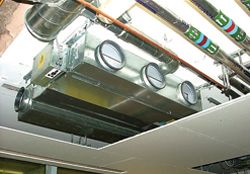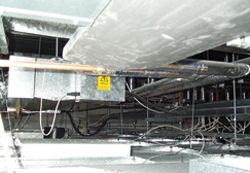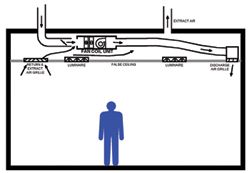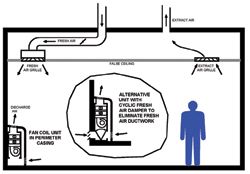Hydraulic fan coil units can offer an energy efficient means of providing air conditioning for a range of commercial buildings, says Mike Price
Fan coil unit installations have become one of the most popular means of providing air conditioning in new build and refurbished commercial premises.
Their benefits include:
• Significantly smaller ventilation plant and distribution ductwork than an all-air system.
• High cooling capacity.
• Comparatively low capital equip-ment cost.
• Individual zone control of space temperature, if suitable controls fitted.
• Flexibility to accommodate future changes in load and space layouts (office 'churn').
• Comparatively low energy consumption when using high efficiency fan motors.

Figure 1
Fan coil units are particularly suited to applications with intermittent medium to high sensible cooling loads and where close humidity control is not required, for example, offices, hotels, restaurants, etc.
Most of these installations use chassis-style units mounted in the ceiling void because they do not then have to occupy floor space within the building. Some projects, however, still specify vertically floor-mounted cased/ recessed units installed at the building perimeter.
Fan coil unit installations are intended to provide comfort conditioning at the specified environmental conditions within the space. While not an inherently complicated system, a number of problems can arise with fan coil unit installations, such as those related to noise, thermal output and draughts, and care needs to be taken in the manufacture, design, selection and installation of the equipment to avoid common pitfalls.

Figure 2
An ideal primer covering all aspects of fan coil unit technology is
CIBSE Technical Memorandum, TM43 'Fan coil units', which sets out to explain the technology including guidance and advice on the common problems encountered.
The HEVAC Fan Coil Unit Group also has technical information on the FETA website, including an FCU acoustic guide and position statements on airflow commissioning, acoustic design principles, FCU entering air temperatures and specific fan powers.
Figures 1 and 2 illustrate ceiling void mounted fan coil units in the process of being installed and show the water, ductwork and electrical services connected to the units.

Figure 3
By way of explanation, fan coil units mainly recirculate return air from the room but fresh air can also be introduced via the fan coil unit. Figure 3 shows how the fan coil unit and other ventilation services are positioned within a ceiling void.
The ceiling void is used as a plenum for the return air from the room to be re-conditioned and for the introduction of ventilation fresh air from a central plant air handling unit (AHU). These two air flows are introduced into the vicinity of the fan coil unit air inlet and are then drawn into the unit for conditioning.
Vertically floor-mounted, cased or recessed fan coil units normally provide air conditioning at building perimeter locations, such as under windows where cooling loads can be higher (see Figure 4). They can also be suitable for compartment enclosures within the building core.
Fan motors and the energy they consume to produce an air flow rate through the fan coil unit has become a crucial factor in the choice of fan coil units as an air conditioning system. A measure of the efficiency of the fan and motor is specific fan power.
The Non-Domestic Heating, Cooling and Ventilation Compliance Guide (the second tier document referred to in Building Regulations Approved Documents L2A and L2B) limits specific fan power of fan coil units (SFPfcu) to a maximum of 0.6 W/(l/s). Notwithstanding this, designers may specify SFPfcu values lower than this in order to realise their required building services design when evaluating the building emission rate with an approved NCM calculation tool.
Generally, this can now only be achieved using fans fitted with a good four-pole AC motor or an electronically commutated (EC) DC motor. EC fans can be used with energy-saving controls to further promote energy efficiency, using the fan at its maximum 'design-day' duty only when this is required. Most of the time, the fans operate well below their maximum speed, resulting in significant energy savings.

Figure 4
There are a number of design features that can be incorporated into fan coil unit systems to reduce the building emission rate further still. Good commercial building design simulation software packages, validated against the National Calculation Methodology, should be able to incorporate all these features into their emission calculation:
• Fan coil units to do the entire cooling load and the majority of the heating load. The fresh air AHU operates with a depressed heating set point.
• Improved fan technology can be incorporated into the fresh AHU to reduce the specific fan power of the central plant.
• Fan coil units with oversize cooling coils can be specified for use with lower grade (higher temperature) chilled water. This will promote more efficient operation of the central plant chillers or enable free cooling systems and ground source heat pumps.
• Two-port water control valves can be used to promote energy savings by reducing the water flow rate of system pumps below their 'design-day' performance level for part load conditions.
• The fresh air AHU and its associated energy emissions can be replaced by fresh air ducted direct to the fan coil units. The use of an advanced damper system could provide a fan coil unit that operates in recirculation and fresh air modes but still satisfies Part L building air leakage requirements.
Commissioning of the fan coil unit installation is essential to ensure it operates in accordance with the client's specification, the contract requirements of the project and the manufacturer's quotation. It is also important to ensure that the air conditioning system will operate efficiently and the customer has a 'soft landing' when the installation is handed over to them.